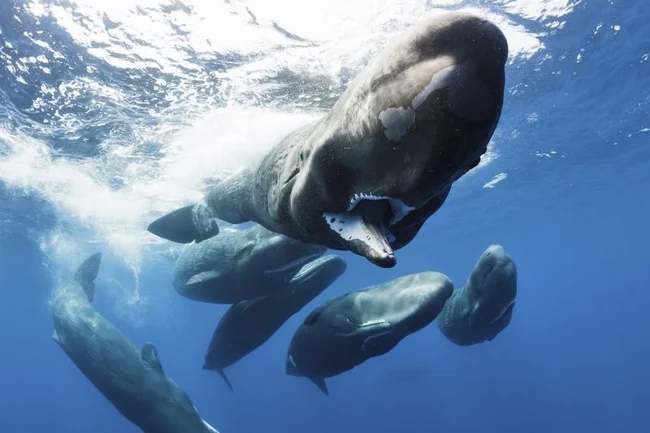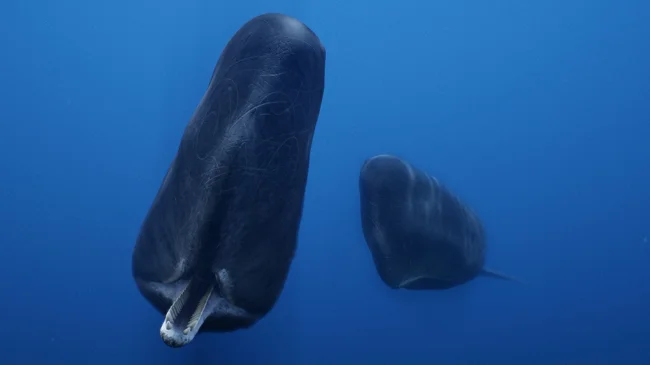How Sperm Whales Communicate with Each Other (6 photos + 1 video)
Sperm whales communicate with each other using a unique speech of short and long repeated clicks 
Sperm whales are not only giants of the ocean, but also masters of communication. Their underwater conversations resemble a chat in a messenger, only instead of emojis, there are sound signals that can be heard even from a distance of several kilometers. Of course, you will not hear them discussing a recipe for squid stuffed with fish. But they are quite successful, for example, in coordinating their actions during a hunt. And this is only one of the few purposes of their communication. 
"What's so surprising about interspecies communication?!", you might ask. Indeed, nature has not been stingy with various methods of social interaction for different species of birds, animals, insects, and even plants. Some have learned to communicate with gestures or even dances, while others communicate with smells, ultrasound, etc. But, for the most part, these "languages" are not particularly complex and are limited to just a couple of elements that are combined with each other depending on the essence of the "message".
But just think about it: sperm whales are able to emotionally embellish their speech, perhaps adding their attitude to what was said or highlighting important elements, indicating their intentions and individual preferences. They are able to convey subtle nuances of meaning in messages to each other depending on the context. Their repertoire includes friendly songs, serious debates about the best actinic algae, and probably gossip about neighboring dolphins. 
The most fascinating aspect of sperm whale communication is their sound "production". Thanks to the research of scientists dedicated to deciphering the phonetic alphabet of sperm whales, it is known that just as we can make different words from the same letters, they make their "words" from codes (sequences of clicks emitted by sperm whales). Watch the short video below:
But the most amazing thing begins when we pay attention to certain components of their "speech":
Rhythm: A certain sequence of intervals between clicks, creating a unique sound pattern.
Tempo: The speed at which clicks are produced, determining the duration of the code.
Rubato: A smooth change in tempo during a conversation, similar to a musical technique when a performer slightly slows down or speeds up the tempo.
Ornaments: Additional clicks that give codes special expressiveness and uniqueness.
Sperm whales use a combination of these components very successfully, similar to how we combine lip and tongue movements to produce a set of phonetic sounds. Until now, it was believed that such complexity of language is inherent only to humans. To make it easier to understand how this system works, imagine how a person pronounces one letter "a-a-a-a". With fear. With surprise. With bewilderment. With understanding of the above.

Moreover: Different populations of sperm whales have been identified as having "dialects". This indicates cultural conditioning and the inheritance of communication features within a formed group. From an early age, they remember and repeat the "speech" of their relatives.
Speaking of children! If you think that only human babies are capable of announcing their presence to all the neighbors in the house as loudly as possible, then small sperm whales (as absurd as it may sound, because the weight of newborn sperm whales is on average 1 ton) are capable of producing sounds reaching 162 dB, with a level of 230 dB for adults - it's as if you were standing next to a launched rocket!

If you want to listen to how their communication is heard in the underwater world, I advise you to limit yourself to an Internet request, because the clicks of these animals are powerful enough to easily rupture eardrums or cause a deadly vibration in the body.
A baby sperm whale is sometimes found quite far from its parents, but this does not mean that it has run away, offended by its strict mother. In addition to the sounds intended for communication, sperm whales are able to make sounds for orientation in space, searching for prey, and they know where their relatives are many kilometers ahead (about 1600 km). “If I had such a cat…” we would not have invented the Internet and cell phones for a long time.

There is no Wi-Fi or selfies in their world, but sperm whales are able to communicate in a way that only true masters can. It is not surprising that if we manage to decipher and understand the meaning of their “words”, we will hear them discussing the politics of the deep waters, because even underwater there is something to talk about!


























